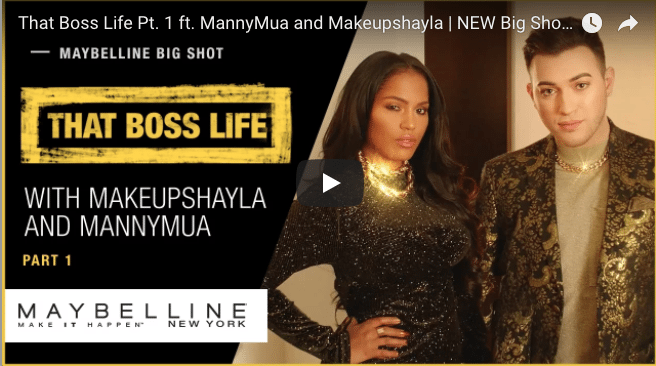BLOG
The Changing Face of Beauty eCommerce: An Interview with Maybelline New York
Published: Apr 3, 2018
We caught up with Ella Tsang, Digital Specialist at Maybelline New York Canada to understand how the iconic brand is navigating the challenges and changes within beauty eCommerce. Read on to get the scoop on leveraging influencers, working with Amazon, and building loyalty.

Yieldify: Social media has been credited with the democratization of the beauty industry, helping independent brands like Glossier reach audiences previously unheard of. As a more established player, Maybelline is considered somewhat of a master when it comes to social media. Can you tell us more about where influencers fit in when it comes to engaging your eCommerce visitors?
Ella: We work with a lot of social media influencers to have an always-on presence, it’s not just for campaigns but really trying to seed our products in advance to influencers to create a buzz.
Usually, we start with the influencer at the beginning of a campaign to build awareness and to help capture our audience’s attention. Then after that, we’ll follow up with a retargeting phase with a very specific conversion type call to action.
We’ll drive visitors to our site for purchase as we have an integration called Shoppable, which allows us to handle transactions on our site, even though those transactions are fulfilled by our e-retailers such as Walmart.

Yieldify: Speaking of Amazon, can you tell us a bit more about how as a mass brand you work with different retailers, and if there are any challenges or benefits associated with that?
Ella: We’re testing lots of different campaigns and initiatives directly with our retailers, especially on Amazon as they’ve now launched Amazon Marketing Services (AMS) in Canada. So for example, bidding on certain keywords, so that when people are on Amazon searching for a keyword like “mascara”, we’re there front and center.
We’re really trying to understand the types of campaigns that Amazon can run for us, and the success these can generate. They know their audience and their customers very well, so this is a big opportunity and part of the reason why we’re testing these different types of campaigns with them.
Yieldify: It sounds like you’re working quite closely with Amazon, can you tell us more?
Ella: Sure, so we’ve got an upcoming launch where we’re testing different ad types, working directly with them to drive to the product page on Amazon.
This will enable us to see what the impact is. In the future it’s this type of collaborative approach that I see us moving toward as it’s mutually beneficial – it’s not only a partnership just for us to make the sale, but it’s really about how do we as a brand elevate websites like Amazon as a beauty eCommerce retailer, as a lot of people don’t necessarily think about going there to purchase their make-up.
Yieldify: What are the challenges associated with selling via other retailers, and what have you found works well?
Ella: In terms of the customer journey, sometimes we drive to our site for purchases, but we also need to look at driving directly to e-retailers, like Walmart.ca and Amazon.ca to make it as smooth of a journey for our consumer as possible.
There are many things that we’re testing and learning from along the way. What we have found is that by sequencing our messaging, first exposing the audience to a more generic product awareness type ad, involving influencers, more generic product benefits and then re-targeting them with more specific messaging to purchase, this works well.
One of the challenges when trying to do this is being able to access customer data and really understand which digital campaigns specifically led to the sale. With our retailers, we have limited information and that’s one of the key drawbacks of not being in e-commerce ourselves. We don’t necessarily have a clear tracking of the entire journey. But as much as possible we’re trying to test and see how do we get as clear of an ROI number as we can get to.
Yieldify: So far, we’ve talked about the customer journey leading up to the conversion, what about after that, how does Maybelline go about creating loyalty?
Ella: Loyalty is something that we’re still working towards. It’s difficult, again linked to the idea of not really owning all the data. Historically all the purchases that are happening online have been directly through the e-retailer site, but this is something we are trying to address. For example, we’re working with Shoppable, a checkout technology, so that visitors are able to add to cart on our site and complete the purchase, but the order itself is fulfilled by the e-retailer.
From there we’re actually able to keep the data relating to every single conversion and this is a huge step for us as we really have the full picture of our consumer. This gives us a lot of opportunity from a customer loyalty perspective, as we can work on things like following up via email, asking the consumer, “How was your purchasing experience?” Really trying to keep up that conversation with her after her purchase on our site.
Also, because we now know what a customer has actually purchased we can start thinking about how do we then continue to personalize her experience? Something such as another product that might be complementary, building her basket outside those things we already know that she likes. That’s the direction that we’re moving in. It’s really about having that knowledge of people who purchase online and being able to personalize their experience better.
Thanks Ella for sharing your insights!